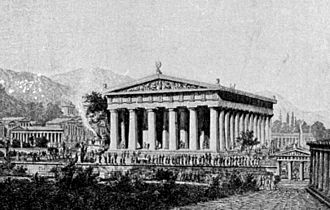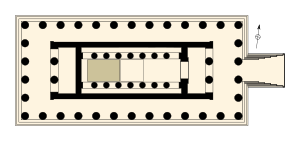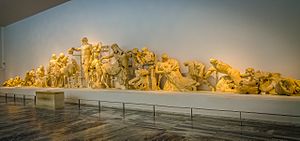Temple of Zeus, Olympia facts for kids
Quick facts for kids Temple of Zeus |
|
|---|---|

Wilhelm Lübke's illustration of the temple as it might have looked in the fifth century BC
|
|
| General information | |
| Type | Greek temple |
| Architectural style | Ancient Greek architecture |
| Location | Olympia, Greece |
| Construction started | c. 489 BC |
| Completed | c. 463 BC |
| Destroyed | 426 (sanctuary), 522, 551 |
| Height | 68 feet (20.7 m) |
| Technical details | |
| Size | 236 by 98 ft (72 by 30 m) |
| Design and construction | |
| Architect | Libon |
| Other designers | Paeonius, Alcamenes |
The Temple of Zeus at Olympia was an amazing ancient Greek temple. It was built in Olympia, Greece, and was dedicated to the powerful god Zeus. This temple was built between 489 BC and 463 BC. It became a perfect example of the classic Greek temple style, known as the Doric order.
Contents
Where Was the Temple of Zeus Built?
The Temple of Zeus was built in a very old religious place. This area in Olympia, Greece was called the Altis. It was a special enclosed area with a sacred grove (a group of sacred trees). There were also open-air altars and a burial mound for a hero named Pelops. This sacred site began to form a very long time ago, around 1000 to 800 BC. This was during a period known as Greece's "Dark Age". During this time, followers of Zeus and Hera came together at this spot.
What Did the Temple of Zeus Look Like?
The Temple of Zeus had a special design. It was a peripteral temple, meaning it had columns all around its outside. It also had a front porch, called a pronaos. There was a similar porch at the back, called an opisthodomos.
The whole building sat on a platform with three steps. This platform is known as a crepidoma. The outside columns were arranged in a pattern of six columns at the front and back, and thirteen columns along each side. Inside the temple, the main room was called the cella. Two rows of seven columns divided this inner room into three walkways. Another temple, the Second Temple of Hera in Paestum, looks very similar. It was built using the same design.
Pausanias, a traveler from ancient times, visited the temple around 150 AD. He wrote that the temple was about 20.7 meters (68 feet) tall up to its roof. It was about 29 meters (95 feet) wide and 70 meters (230 feet) long. You would walk up a ramp on the east side to enter the temple.
The main part of the temple was made from local limestone. This stone wasn't very pretty or strong. So, builders covered it with a thin layer of stucco. This made it look like expensive marble, matching the beautiful sculptures. The roof was made of Pentelic marble tiles. These tiles were cut so thin that light could shine through them. Imagine a sunny day, and light like a small light bulb would glow through each of the 1,000 tiles!
From the edge of the roof, there were 102 waterspouts. These were shaped like lion heads and worked like gargoyles. Today, 39 of these lion heads still exist. Different styles of spouts show that the roof was repaired during the Roman period.
Amazing Sculptures and Decorations
The temple was decorated with amazing sculptures made from imported Parian marble. These included carved panels called metopes and decorative strips called triglyph friezes. On top of these were large triangular sections called pediments. These pediments were filled with sculptures in a style known as the Severe style. Experts believe these were made by a group of artists called the "Olympia Master" and his workshop.
The sculptures on the Eastern pediment showed a chariot race. This race was between a hero named Pelops and King Oenomaus. The Western pediment showed a battle between humans and mythical creatures called Centaurs. This battle is known as a Centauromachy. The god Apollo is shown on the western pediment, pointing towards the human side. This showed he favored them in the battle. Pausanias wrote that Paeonius created the Eastern pediment sculptures. He said Alcamenes carved the Western ones. The metopes (panels) on the temple showed the twelve amazing tasks of Heracles.
The Giant Statue of Zeus
Inside the temple was the famous statue of Zeus. This statue was so grand that it was one of the Seven Wonders of the Ancient World! The statue was made of gold and ivory, a style called Chryselephantine. It was about 13 meters (43 feet) tall. The famous sculptor Phidias created it in his workshop right there at Olympia. It took him about 13 years (from 470 to 457 BC) to finish this masterpiece. It was one of the most respected artworks in ancient Greece.
When the huge statue was put in place, the temple's inner room (cella) had to be changed a lot. The inside columns were taken down and moved. This probably meant the roof tiles had to be replaced too. The original floor was made of large stone blocks. It was covered with a special lime material that kept water out. This likely helped protect the statue's ivory parts from getting damp.
What Happened to the Temple?
In 146 BC, a Roman general named Mummius placed 21 gilded (gold-covered) shields on the temple. He did this after winning a battle in Corinth. Later, in 426 AD, a Roman emperor named Theodosius II ordered that the temple be destroyed. This was part of a time when pagan (non-Christian) places of worship were being removed.
Archaeologists believe that the already damaged temple was finally destroyed by strong earthquakes. These earthquakes happened in 522 AD and 551 AD. They caused a lot of damage in the area. However, some experts now think the columns might have been pulled down on purpose by ropes around that time. The area was later covered by floods from the Kladeos river. Eventually, the entire site was buried under up to 8 meters (26 feet) of dirt and mud.
The ancient site of Olympia was forgotten for a long time. Then, in 1766, an English expert named Richard Chandler found it again. In 1829, a French team of archaeologists started digging. They clearly identified the Temple of Zeus and began to uncover it. They even took some pieces of the sculptures to a museum in Paris. Serious excavations began in 1875 by the German Archaeological Institute at Athens. Digging and studying the site continues even today!
See also
 In Spanish: Templo de Zeus Olímpico (Olimpia) para niños
In Spanish: Templo de Zeus Olímpico (Olimpia) para niños
- List of Ancient Greek temples
- List of Greco-Roman roofs




